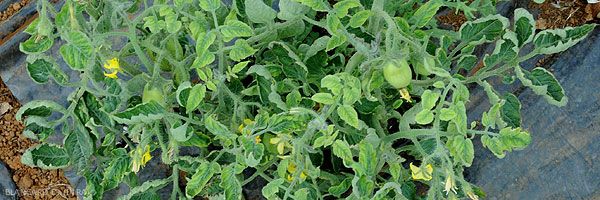
Tomato yellow leaf curl virus
(TYLCV)
Yellow leaf virus in tomato spoon
and other associated viral species
,
,
- classification : Geminiviridae, Begomovirus
- Former subgroup III of the Geminivirus group
The virus yellow leaf curl of tomato ( Tomato yellow leaf curl virus , TYLCV) and viral species associated with the syndrome yellow leaf curl are now widespread in many countries on all continents.
TYLCV is very present in several countries of the South Mediterranean, in the Near and Middle East, and in certain countries of Sudano-Sahelian Africa such as Senegal or Burkina Faso. It was detected in Reunion Island in 1997. It is also found in Morocco and the Canary Islands, with TYLCSV. This virus is also rife in Italy, Sicily and Sardinia (since the end of the 1980s), as well as in Calabria (since 1991). In Spain, Andalusia has been particularly affected since 1993 by the TYLCSV, then also by the TYLCV. Its extension is progressing; damage was reported in 1995 in Murcia and Alicante, then in Portugal in the Algarve region. TYLCV or other viral species are also reported, among others, in Eastern Europe, Asia (Iran, Turkmenistan, China, Nepal, Thailand, Taiwan, Japan ) and Australia. TYLCV seems to have reached the American continent: Dominican Republic (1997), Cuba (1998), Florida (1999), Jamaica (1999), Mexico (1999), Guadeloupe (2001)
It was occasionally detected in France from the end of the 1990s. It was in the Camargue, in 1999, that the first outbreak was identified, following the introduction of plants originating in Spain. It is now permanently installed in the Pyrénées-Orientales, where it is found in wild plants outside shelters.
Several factors have strongly contributed to the spread of TYLCV around the world:
- the characteristics of the vector whitefly for this Begomovirus, Bemisia tabaci (various biotypes), a highly polyphagous whitefly parasitizing at least 500 plant species, and whose population levels are often very high;
- the sensitivity of the cultivated tomato varieties and the continuity of production;
- the migration of virulent aleurodes, from old tomato crops or other sensitive plant species to recent plantations;
- large-scale marketing of infected tomato plants.
The economic losses caused by TYLCV are often very significant in the countries where it is rife. Several studies show drops in yield exceeding 50%, or even 60%, compared to uninfected controls. If the attacks are very early, the harvest can be completely compromised.
TYLCV (figure 1) is not a virus of recent appearance since its first attacks on tomato were reported in Palestine in 1939. It seems to have been disseminated from infected plants or following the migration of its insect. vector: Bemisia tabaci .
 |
| Figure 1 |
The emergence of syndrome yellow leaf curl , in many countries, gave rise to the description of several strains of TYLCV initially: TYLCV-Ch (China), TYLCV-Is (Israel, also including strains from Egypt and Lebanon), TYLCV-Ng (Nigeria), TYLCV-Sar (Sardinia), TYLCV-SSA (Southern Saudi Arabia), TYLCV-Tz (Tanzania), TYLCV-Th (Thailand), and TYLCV-Ye (Yemen)? ?
Subsequently, thanks to the study of the percentage of genomic identity, these and new strains were reclassified as internationally recognized species: Tomato yellow leaf curl virus (TYLCV, integrating the original virus as well as the Israel and Almeria strains ), Tomato yellow leaf curl Sardinia virus (TYLCSV), Tomato yellow leaf curl Malaga virus (TYLCMalV, which would be a recombinant between TYLCV and TYLCSV), Tomato yellow leaf curl China virus (TYLCCNV), Tomato yellow leaf curl Kanchanaburi virus (TYLCKaV), Tomato yellow leaf curl Thailand virus (TYLCTHV)
We can also add “potential” species not yet fully validated internationally, such as Tomato yellow leaf curl Nigeria virus (TYLCNV), Tomato yellow leaf curl Kuwait virus (TYLCKWV), Tomato yellow leaf curl Saudi Arabia virus (TYLCSAV) , Tomato yellow leaf curl Tanzania virus (TYLCTZV), Tomato yellow leaf curl Yemen virus (TYLCYV) Note that the situation is comparable for other viruses, in particular ToLCV.
Other viral species are associated with yellow leaf curl and it is likely that other species will be described, resulting in a permanent evolution of the situation of Begomovirus on tomato and probably of the taxonomy of these viruses.
In conclusion, we must be aware that all these viral species reveal, in the state of our knowledge, comparable biological properties. In order to avoid redundancies, we will only develop knowledge relating to TYLCV. These should give you enough information to be able to interpret and manage epidemics linked to other Begomoviruses. Let us add that all the viruses transmitted by Bemisia tabaci are considered as quarantine viruses.
TYLCV virions are found in the nuclei of leaf parenchyma cells. They are twin, angular, and measure approximately 20-30 nm in diameter (Figure 1).





